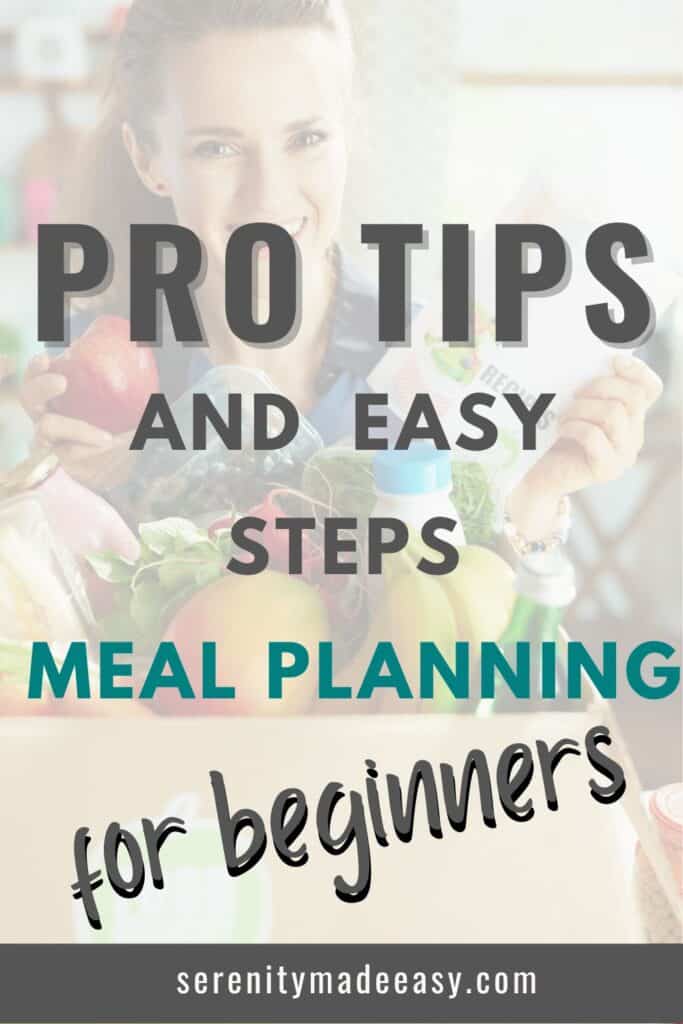This post may contain affiliate links. If you click one and make a purchase, I earn a small commission at no extra cost to you. It helps support the site so I can continue to offer great content to you!

Most households would agree that one of the most stressful times of the day is dinner time. So many decisions and so many things that can go wrong. Deciding what to make for dinner, having all the correct ingredients on hands and getting it on the table in a timely manner can be a daily struggle. This blog post is filled with tips and explain a step by step approach to meal planning for beginners.
Therefore, if you spend too much time throughout the day thinking about what to cook for dinner, this article is for you. If you get home and draw a blank while looking in the fridge, this article is for you. If your children, significant other, or roommate ask what is for dinner on repeat, this article is for you.
Meal planning for beginners tips
Give meal planning enough time
You will not be an expert at this after one week. Give yourself time to implement the recommended steps and tips. It is normal to feel a little all over the place the first few times you go through this exercise. Meal planning will become easier over time and it will save you time, money and reduce unnecessary food waste and stress once you have mastered it. Therefore, give it a month (3 or 4 planning sessions) to feel the full benefits of meal planning.
Be realistic
Ask yourself how many meals you can truly commit to making at home every week. If you are starting from a place where you eat out 4 times a week, be realistic to slowly transition to cooking and eating at home more frequently. Set a goal and stick with it for the next several weeks before increasing the frequency of at-home meals.
Do some prep work
First, it is strongly recommended to do some prep work before embarking on the meal planning journey. Create a list of all your favorite recipes. Start with 20 to 30 so that you are not overwhelmed with the process. Choose the system that works best for you. You can print all the recipes and put them in a binder or create a new board on Pinterest to gather all the recipes in a single location.
You will not need to do this on a weekly basis. It is an investment you are making up-front so that your weekly meal planning session is quick and easy. Over time, you can add additional recipes you want to try or that you have tried and want to include into your regular meal planning.
Second, create a grocery list template with items you buy every week. Think about breakfast, lunchbox, and snack items. Having those default items on your template will make your weekly meal planning session quicker. Organize the list the same way your grocery store is laid out. If the produces are first, list them first for example. This will be a big time save when you shop and reduce your likelihood to forget something. Have this list easily available, either electronically or on paper, and add things you will need to purchase next week as you go when you think of it. If you are looking for an electronic note app, check out Goodnotes.
Cook once, eat twice
If cooking more regularly is daunting, consider doubling recipes to have leftovers. You can freeze your leftovers later, eat them for lunch another day, or eat the same meal again for dinner later during the week. Good food is good feed, don’t hesitate to eat it twice!
Why does meal planning works
Meal planning saves you time because you do all the thinking up front at a moment you are calm and focused. Therefore, you have everything you need to be successful throughout the week. You do not make last-minute impromptu trips to the groceries and do not waste time looking through recipes every night to find one for which you have all the ingredients.
You can save a considerable amount of money when meal planning by reducing your food waste and not eating out as often. You can also plan your meals around the weekly sales your grocery store is offering to keep your food expense on a budget.
By following this easy meal planning for beginners guide, you will find that it can improve your ability to have balance and variety in your diet. Alternating the meat/protein in your meals, ensuring you have a wide diversity of fruits and vegetables, and choosing recipes that are in season can all contribute to keeping you and your family healthy.

Meal planning for beginners – 5 easy steps
Step 1: Take an inventory of what you have
The very first step is to review what you already have. This is crucial! You do not want to waste food by purchasing items that you already have. Additionally, identifying items that will soon expire allows you to plan recipes that will use them up before they go bad.
List any items that need to be used. You will reference them in the next step.
Step 2: Look at your calendar
This step is recommended and important because it will help you determine how many meals you are planning for and identify any challenges you might face. Let me explain. You might realize that you have a commitment with friends one evening. Therefore you would not want to plan a meal for that night. Along the same line, if all children have after-school activities on Tuesday, you want to note that you need a quick recipe for that dinner. A make ahead or crockpot recipe can also be a good option for those chaotic nights.
Write down how many meals you need to plan and any special notes that will help you be successful.
Step 3: Pick recipes
Start with the list of ingredients you need to use up this week. Find recipes on the list that you prepped that use some of the food that will expire soon.
If you are trying to stick to a budget, look at the weekly sales for your grocery store and consider items you’d like to purchase based on that factor. Again, find recipes on your list that contain those ingredients. If you do not have a recipe for a certain ingredient but really want to incorporate it into your plan this week, look at new recipes on the internet. Once you’ve tried the recipe, you can add it to your list if you enjoyed it.
Finally, find the remaining meal on your recipe list. Remember to consider how many “quicker” recipes you need based on the review of your weekly calendar in the prior step.
Step 4: Make your grocery list
Review each recipe and add all the ingredients needed to your list. Realistically, you could easily combine steps 3 and 4. Meaning that you can add missing ingredients to your grocery list at the same time that you select the recipe. This way, you do not have to go back to that recipe twice and it will save you additional time. Remember to organize your list in the way your grocery store is laid out. As you get comfortable with the layout, you can even skip isles that don’t contain anything you need. This will reduce the likelihood of getting tempted by unneeded items.
Step 5: Write you meal plan somewhere visible
Put each selected meal on a calendar showing which day you plan to have which meal. Remember to list the meals using ingredients expiring soon, early in the week. Also, remember that your quicker meals should be on your busier days. Make sure to leave this meal plan somewhere visible where your entire household can see it.
Quick note: You do not need to stick to this schedule as the week progress. If you are craving chicken on Tuesday but the chicken meal is planned for Wednesday, you can swap them. The meal plan can be more of a guide that helps you easily go through the week. Just make sure that you eat each meal at some point during the week to avoid waste.
In conclusion…
Meal planning can provide simplicity, cost, and time saving as well as peace of mind to you and your family. It is a simple process you can get through in less than an hour each week. Now that you have read this meal planning for beginners article, you should feel more than ready to give this a try. But if you need a little more help, let me know!
Cat xx

